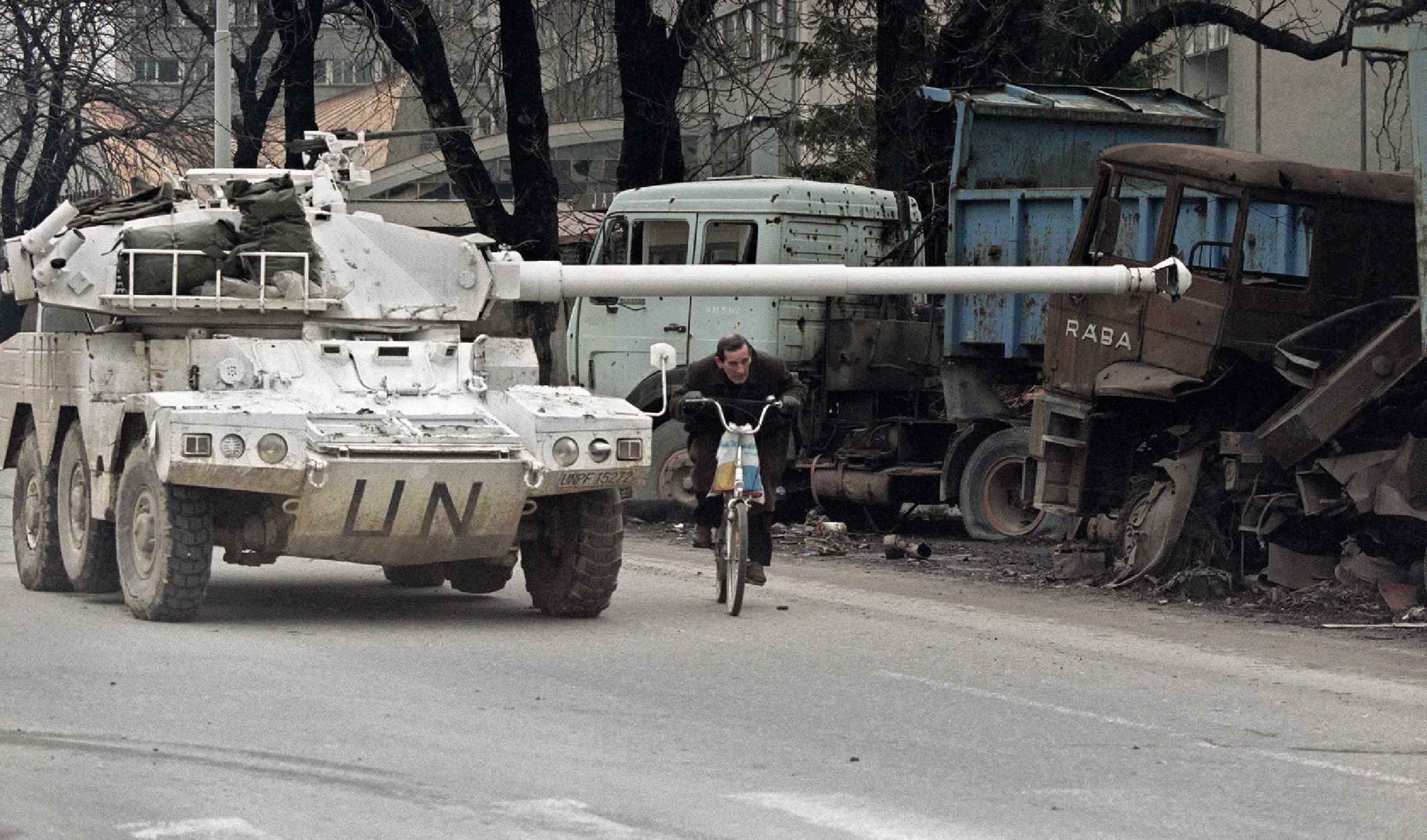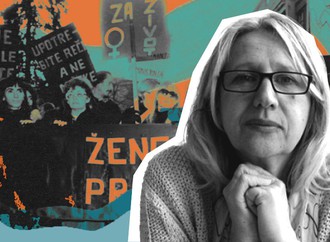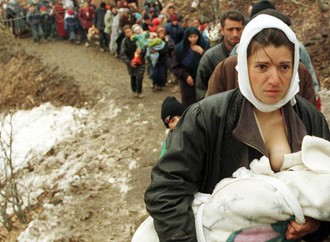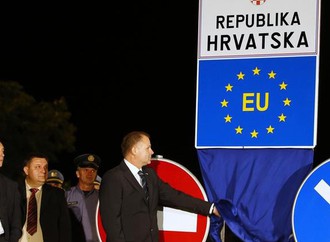Yugoslavia was breaking up for a long time. It had more than 30 years of transition and the country had multiple wars: one in 1991, then another in 1995, 1999 and then the Kosovo struggles. For these reasons alone, Yugoslavia could provide a useful way to approach the question of war and the post-war period.
Michael Perelman spoke about the political economy of war, and I want to focus on how the war created the new ruling classes in Yugoslavia and why this might also be an example for Ukraine and Russia. Besides that, I will focus on the parallel destruction of the working class in the war. Ex-Yugoslavia has never recovered from that, and, in fact, it never will. So if there is a lesson from the mess of Yugoslav collapse, this would be how not to do a post-war reconstruction in Ukraine, and the perils associated with having a ruling class bent on aggression, as it may be in Russia. In that sense, the Yugoslav example could be an illustrative “counter-example” to both aspects of the conflict. In both cases, it warns of what can happen if the ruling classes are given a free hand and not resisted — both during the war and its aftermath.
The IMF dictate and the rise of Milošević
Back in the 80s Yugoslavia was one of the most indebted nations. It experienced a very direct dictate by the IMF. The IMF demanded austerity in all of Yugoslavian republics and provinces, along with the restructuring of the economy along neoliberal lines. That’s where the last working-class movement in the region comes from: from within the 80s. It was against this “tightening of the belt” that we associate neoliberalism with, that a lot of workers’ protests and strikes emerged, and which are completely forgotten today.
One of the proponents of an early form of neoliberalism during the 80’s was Slobodan Milošević: he was pro-market oriented, pro-IMF, pro-private capital and the like. Today his economic program would be considered pro-EU. And it is by posturing as a reformer that he managed to outcompete the anti-IMF part of the party, which became associated with “old socialism”[1]. Simultaneously, the workers were promised a better future, which further pacified any working-class-based socialist resistance. This would provide a key platform for most post-socialist political parties and actors in the future — essentially the new ruling class — which were, en gros, anticommunist in nature, along with the war profiteers to whom privatisations came as a second blessing after the war. Here they could finally reinvest whatever was acquired during the war, be it through looting, blood money, smuggling and the like. As one author, Alpar Losoncz, an economist from the region, put it, the end of the 90s was basically a “post-socialist accumulation by dispossession”. After the war, the working class, as a subject, became a thing to be omitted.

Slobodan Milošević
But soon these promises hinged more and more on competing with workers and parties from other republics, and, ultimately, nations. Yet, seeing Milošević as a reformer, a lot of people voted for him in the 80s not knowing that he would turn to nationalism and instigate the war. When that happened, the economy completely started to collapse. As an aggressor nation like Russia today, post-1991 Yugoslavia, now under the hegemony of the Serbian ruling class around Milošević and his state apparatus, had sanctions due to the war in Bosnia from 1992 to 1995. These had a debatable effect (although a deeper one than in Russia), but Milošević and his clique made sure that the working class got hit, by allowing inflation to skyrocket through money-printing in order to destroy working class savings, and in general, cripple working class power while infusing them with nationalist ideology that glorified the Serbs as a “heavenly people”[2].
On Earth, things looked hellish, to say the least. Any index, any statistic shows Serbia's collapsing industrial output in those years. Since 1986, if one takes that year as a base, it declined to 90% in 1990 and to 41% from 1994-1998. Machine output fell by three quarters and an impoverished population had to forego consumer goods[3]. Agriculture was rising, industry was in decline, technology became obsolete. This would set the stage for post-war “recovery” after Milošević: reliance on foreign direct investments and credits, privatisations of “non-profitable” socialist enterprises and the question of what to do with Milošević’s cadres, which was in fact, never answered.
One of the consequences of that these cadres re-emerged after the crisis of 2008, reformed into the party called “Serbian progressive party”, and won elections while running on an anti-corruption campaign targeting failed privatisations and the unemployment they created - basically the post-Milošević remedy to what Milošević himself caused. These then produced the current president of Serbia, a former Minister of Information in Milošević’s regime, tasked with controlling the media. The ruling class was never different: its path can be tracked back in post-war, war and pre-war accumulation.

War in Yugoslavia, 1991-1995
Post-war economy and reconfiguration of the class power
Michael Palairet states that when a war happens, the economy shifts to a different form than it would have been in during its growth phase. If growth means developing industry along higher value-added positions in the economy, if it results in more intellectual labour as a consequence of growth, then the opposite would be expected to happen during the war times after the deterioration of the economy. There would be more agriculture, more labour-intensive sectors, developing capital export, developing corruption and money being taken out of the country. There would be stagnation in technological development.
That is exactly what happened in Yugoslavia. The war had preconditioned the form that both the ruling and working classes will take. Everyone who was educated left the country, leaving the working class without leading figures and without technical cadres which would have been necessary to organize any sort of resistance, while manual labor became disenfranchised. That same manual labor and what was left of the technical cadres struggled against Serbian privatization in the 2000s, but being robbed of resources in the previous rounds of privatization, workers could wage only a desperate kind of struggle. Self-mutilation by the workers was sadly a very common form of protesting. The neoliberal course of development after the wars formed a new ruling class along such liberal lines, that the elite would do everything except recognize any workers’ movement.
So, how was this done in practice? There was a privatization drive already in the 1990s, then - renationalization during the sanctions and privatization under Milosevic. After he fell and after the economy completely collapsed in the 2000s, the country had another round of privatizations. I was writing a study on several factories which were pushed into being privatized, although they were profitable, although the machines were still in a somewhat normal condition and they were exporting. There is the steel industry in Novi Sad, there is the chemical industry in Vojvodina, the region in the north of Serbia: everything was privatized.

The war in Yugoslavia, 1991-1995 years
Even if the state would have a choice, for example, between pushing the workers to unemployment, giving them some social program or saving the factory and cancelling its debts for electricity or heating, it would nevertheless lay off workers and close the plant, privatize it, and sell it off for scraps. Something like this was happening in Germany after the fall of the Berlin wall. There was a scandal between East and West Germany with the privatization agency Treuhandanstalt, which sold factories for 1 DM and basically took over the East German economy. The German privatization model was responsible for an imbalance in the contemporary German economy between the east and the west. The result is more progress in the west, combined with eastern deindustrialization and west German companies taking over the east, high unemployment and conservative political orientations in the east. Serbia was following this German model: Belgrade companies, for example, taking over the rest of the country.
This created the struggles that my generation had experienced. I come from a leftist Marxist background and we developed ourselves against the background of these workers’ struggles in 2010, 11, 12, precisely in opposition to such privatizations. Perhaps Serbia, or at least its northern parts, had a good political potential in chemical workers, in metal workers – industries which survived the war – although that was not very promising. All of the collapses within Yugoslavia and its labor market and industries preconditioned the failures and meager attempts of the resistance after the war: mostly protests were either ignored by the government or outright attacked, as was the case with a great chemical plant “Jugoremedija” in Zrenjanin.
Once the workers there did start production and some sort of self-management again, resisted privatizations, the government would send dogs: the military and the police. There were even fights and shootings with the workers who used the diuretics as pacifiers, chemical pacifiers shot at the police and army. From these struggles new left-wing organizations would later be born, like the Left Summit of Serbia, and later on, the Party of the Radical Left. So all of these struggles have roots before neoliberalism started to kick in again, and very much before we had flexible labor laws whose introduction we had resisted, and which are now pushed for in Ukraine. Hence, neoliberal flexibilization was preconditioned by the war in which the only winner was the ruling class.
On the other hand, those who fueled and profited off of war propaganda, like Vučić, the current president, now became rulers. So, the war had preconditioned the new ruling classes that are currently in power - this is how long it takes for a war to show its effects. For the West as well as parts of the Serbian left, the explanation that was told was one of ethnic hatred between peoples, Serbs, Croats, Albanians or any other Balkan people. But that narrative alone does not explain the rise of the new classes nor the resistance to the war by masses of people, not least from within the Yugoslav Army, which had trouble conscripting less than 50% of the population, and even lower in Belgrade itself.

Croatian soldiers in the Yugoslav war
In Yugoslavia there was a multiethnic population, and it did not want to fight in the war. This is why the war had to be fought with paramilitary organizations, which themselves profited, and in turn, joined the ranks of the ruling class and secret services, making it more and more difficult to actually begin any sort of reconstruction that would be aimed at disempowering the ruling class. The war actually gave the upper classes longevity. They survived the war because they were in power, and they could then use the same assets and political connections to come back again after the crisis of 2008.
Post-war recovery which never happened
During this post-war reconstruction phase, the aggressive disintegration of the former working classes that the war had exacerbated, had been allowed to continue by the new ruling classes that the war had brought forth. In essence, it was precisely because post-war recovery was class-led. One of those consequences was that the working class in Serbia lost all institutions that they had: from trade unions, which were becoming now the long arm of state, to workers’ education. Yugoslavia had a network of over 200 Marxist centers which were educating 55000 people a year in Vojvodina alone: it was presupposed that you cannot run an economy without an educated worker being in a workers’ council. This was important, because Yugoslavia had workers’ self-management before the 90’s. And this was all destroyed. So, workers lost their education, their infrastructure, their savings. The inflation from the war was an attack on private savings by the workers.
At the same time there was accumulation at the top and restructuring, redistribution of the budgets – that is where the new ruling classes were also created. According to statistical data by sociological analysis of class relations, where upper classes are measured by education, income, real estate – it turns out that all of the classes fell down in terms of income, real estate, education, everything. Except for the top 1%; this was the class that we now know as war criminals. One of the lessons from all of this was that nationalists, paradoxically and not so paradoxically, were the first ones to sacrifice their nations and their population.
Secondly, without working class resistance that would halt the war machine, the war had ravaged both Serbia and the states that it had attacked, from which the ruling classes made sure that the region as a whole, formerly known as Yugoslavia, would never recover. Post-war recoveries in all states, modeled along the neoliberal lines, only further served the classes that fought within the wars. Hence, one can look at ex-Yugoslavia to understand why such a post-war reconstruction scenario must be avoided in Ukraine. But also at the same time, Serbia might be an example of what might happen to a society after it starts a war of aggression, like Russia did.
Footnotes
- ^ According to research done by the Party’s Marxist centers, the membership of the Party also dwindled as workers collectively left the Party, leaving it with an upper-class leadership coming from the military, the police, directors of enterprises, bankers, etc. These Marxist centers were soon closed down by Milošević, pacifying any internal resistance.
- ^ Today, this ideology has been expanded upon by copying a concept of a social totality taken precisely from Russia: the “Serbian world” (modeled on the doctrine of the “Russian world”/”Русский мир”), meaning that there are Serbs in other nations which should be part of Serbia.
- ^ Michael Palairet, The Economic Consequences of Milošević, Europe-Asia Studies, Vol. 53, No. 6 (Sep., 2001), p. 909.Available at: https://www.jstor.org/stable/826446





